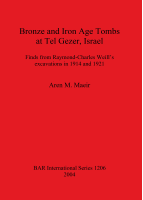Description
BOOK DESCRIPTIONThe ancient site of Tel Gezer (Abu-Shûsheh/Tell Jezer/Tell el-Jazari) is located in Central Israel, approximately halfway between Jerusalem and Tel Aviv. It is situated in the northern section of the Judean foothills (Shephelah), not far from the southernmost hills of south-western Samaria. Raymond-Charles Weill commenced his career in archaeology and Egyptology at a relatively late age. After receiving his training in Egyptology and archaeology in France, Baron Rothschild invited him to excavate in Jerusalem, on lands belonging to the Baron. These excavations were conducted both before (in 1913-1914) and after (in 1923-1924) the First World War, and were duly reported by Weill (1920; 1947). Apparently, ancient tombs had been revealed on the site by the settlers, and Weill, who by chance was excavating at the time for the Baron in Jerusalem, was called in to excavate at Gezer. Both seasons of Weill's excavations at Gezer (in 1914 and 1924) coincided with his work in Jerusalem. His results were never fully published, and this present volume represents the author's long researches to make some of Weill's discoveries more widely available. Following the introductory chapter, the author and various contributors discuss and analyze finds from the tombs. In Chapter 2, N. Panitz Cohen and the author discuss the pottery from the tomb. In the following chapter, Chapter 3, the same authors discuss the stone, faience, bone, and metal objects. In Chapter 4, D. Barag discusses the Egyptian 18th Dynasty glass vessel from the tombs, a unique vessel and one of the more important finds from the tombs. In Chapter 5, O. Keel discusses the glyptic finds from the tombs, which included three scaraboids and one stamp seal. In Chapter 6, N. Applebaum, who conducted radiographic analyses of a sample group of vessels from the tombs, discusses the technological conclusions reached from this analysis. Chapter 6 presents a summary discussion of all the various finds. With contributions by Nava Panitz-Cohen, Dan Barag, Othmar Keel, Nachum Applbaum and Yaakov H. Applbaum











